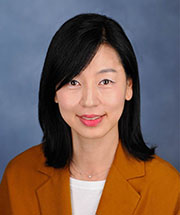Facial characteristics of female candidates hinder electability by conservative voters, but not liberals

LAWRENCE — A conservative-majority America may never elect a female president.
At least that is one takeaway from new research arguing a perceiver’s political orientation biases their judgment of a candidate’s electability based on facial characteristics and stereotypes associated with gender.
“Facial information forms that first impression within less than a second. Other information may override it. But it may not,” said Ahreum Maeng, associate professor of marketing at the University of Kansas.
 Her new article titled “The Face of Political Beliefs: Why Gender Matters for Electability” reveals how American conservatives and liberals read dominance signals differently when exposed to facial cues from men or women. Conservatives show stronger bias against female faces because they are less likely to elect female candidates due to their association with lower dominance, according to the study, which will appear in the Journal of the Association for Consumer Research.
Her new article titled “The Face of Political Beliefs: Why Gender Matters for Electability” reveals how American conservatives and liberals read dominance signals differently when exposed to facial cues from men or women. Conservatives show stronger bias against female faces because they are less likely to elect female candidates due to their association with lower dominance, according to the study, which will appear in the Journal of the Association for Consumer Research.
Co-written by Pankaj Aggarwal of the University of Toronto, the research centers on the width-to-height-ratio (fWHR) of a person’s face. Higher ratios are known for signaling a dominant personality and stronger leadership traits. Using controlled experiments and an archival study, they found that although fWHR is positively correlated with dominance evaluations of male faces, the same attribution is less likely to be made for female faces based on one’s political affiliation.
“This study shows that metric automatically triggers dominance perception in the person. So then it really doesn’t matter whether that person is behaving dominantly or behaving trustworthy. It just makes the perceivers see that person as more dominant and aggressive, and then therefore cannot be trustworthy,” Maeng said.
Previous research cited in the article suggests that conservatives hold stronger female stereotypes than liberals, and political conservatism is positively associated with hostile sexism. But why do conservatives show stauncher bias than liberals against female faces specifically?
“I don’t know whether it’s a bias or not,” Maeng said. “Both liberals and conservatives have an expectation of females being more communal compared to the male. I think that’s common. But conservatives have a stronger expectation from the female on that trait. So when they see that dominance signal from the wider female faces, it backfires, and they suppress more. Therefore, they see wider as less dominant,” she said.
“For liberals, assertiveness and dominance may not even be a factor that they consider for leadership. I don’t know what they look for, but at least I can say that trait is not what they looking for,” she said.
Maeng emphasized her findings have implications not simply for elected officials but for female leadership in general.
She said, “Females often face more challenges in obtaining leadership positions. Because of this, people’s expectations of females being communal, nicer, more friendly or less assertive is especially prevalent in a domain where they expect strong leadership, like politics or business. Not like teachers and social workers.”
Now in her ninth year at KU, the South Korea native’s expertise focuses on consumer behavior. Her initial research with width-to-height-ratio involved how consumers perceived automobile designs in an article titled “Facing Dominance: Anthropomorphism and the Effect of Product Face Ratios on Consumer Preferences” (also cowritten with Aggarwal) for the Journal of Consumer Research. That triggered her current four-year research project.
“More and more countries are now seeing leadership from females. We can say that dominance and assertiveness and aggression, those are not what make most female leaders successful. They are showing different leadership styles, and that works very well,” Maeng said.
As for whether America will ever politically embrace the idea of a female president, Maeng is cautiously optimistic.
“It is important we can teach or educate people that ‘stronger leadership’ is not always the best, and you can give opportunities for those who don’t have stronger assertive characteristics more chances to be in the role of leadership,” she said. “Then people who experience this can be more open-minded to other types of leaders.”
Read this article on the KU News website.
Top photo: iStock